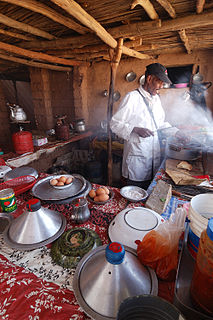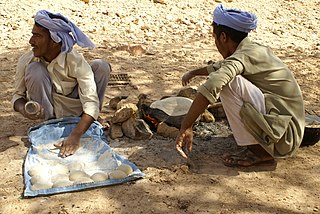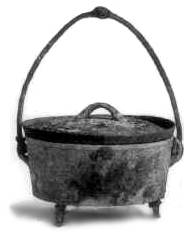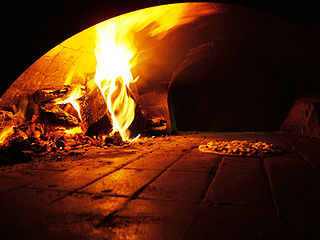
Cooking or cookery is the art, technology, science and craft of preparing food for consumption. Cooking techniques and ingredients vary widely across the world, from grilling food over an open fire to using electric stoves, to baking in various types of ovens, reflecting unique environmental, economic, and cultural traditions and trends. The ways or types of cooking also depend on the skill and type of training an individual cook has. Cooking is done both by people in their own dwellings and by professional cooks and chefs in restaurants and other food establishments. Cooking can also occur through chemical reactions without the presence of heat, such as in ceviche, a traditional South American dish where fish is cooked with the acids in lemon or lime juice.

Barbecue or barbeque is a cooking method, a style of food, and a name for a meal or gathering at which this style of food is cooked and served.

Baking is a method of preparing food that uses dry heat, normally in an oven, but can also be done in hot ashes, or on hot stones. The most common baked item is bread but many other types of foods are baked. Heat is gradually transferred "from the surface of cakes, cookies, and breads to their center. As heat travels through, it transforms batters and doughs into baked goods and more with a firm dry crust and a softer centre". Baking can be combined with grilling to produce a hybrid barbecue variant by using both methods simultaneously, or one after the other. Baking is related to barbecuing because the concept of the masonry oven is similar to that of a smoke pit.

Grilling is a form of cooking that involves dry heat applied to the surface of food, commonly from above or below. Grilling usually involves a significant amount of direct, radiant heat, and tends to be used for cooking meat and vegetables quickly. Food to be grilled is cooked on a grill, a grill pan, or griddle.

Roasting is a cooking method that uses dry heat where hot air envelops the food, cooking it evenly on all sides with temperatures of at least 150 °C (300 °F) from an open flame, oven, or other heat source. Roasting can enhance flavor through caramelization and Maillard browning on the surface of the food. Roasting uses indirect, diffused heat, and is suitable for slower cooking of meat in a larger, whole piece. Meats and most root and bulb vegetables can be roasted. Any piece of meat, especially red meat, that has been cooked in this fashion is called a roast. Meats and vegetables prepared in this way are described as "roasted", e.g., roasted chicken or roasted squash.

Cookware and bakeware are types of food preparation containers, commonly found in a kitchen. Cookware comprises cooking vessels, such as saucepans and frying pans, intended for use on a stove or range cooktop. Bakeware comprises cooking vessels intended for use inside an oven. Some utensils are considered both cookware and bakeware.

Outdoor cooking differs substantially from kitchen-based cooking, the most obvious difference being lack of an easily defined kitchen area. As a result, campers and backpackers have developed a significant body of techniques and specialized equipment for preparing food in outdoors environments. Such techniques have traditionally been associated with nomadic cultures such as the Berbers of North Africa, the Arab Beduins, the Plains Indians and pioneers of North America, and have been carried down to and refined in modern times for use during recreational outdoors pursuits.
A muffin is an individual-sized, baked product. It can refer to two distinct items, a part-raised flatbread and a cupcake-like quickbread. The flatbread is of British or European derivation, and dates from at least the early 18th century, while the quickbread originated in North America during the 19th century. Both are common worldwide today.

A Dutch oven is a thick-walled cooking pot with a tight-fitting lid. Dutch ovens are usually made of seasoned cast iron; however, some Dutch ovens are instead made of cast aluminium, or ceramic. Some metal varieties are enameled rather than being seasoned. Dutch ovens have been used as cooking vessels for hundreds of years. They are called casserole dishes in English-speaking countries other than the United States, and cocottes in French. They are similar to both the Japanese tetsunabe and the sač, a traditional Balkan cast-iron oven, and are related to the South African potjiekos, the Australian Bedourie oven and Spanish cazuela.

An oven is a thermally insulated chamber used for the heating, baking, or drying of a substance, and most commonly used for cooking. Kilns and furnaces are special-purpose ovens used in pottery and metalworking, respectively.

A kitchen stove, often called simply a stove or a cooker, is a kitchen appliance designed for the purpose of cooking food. Kitchen stoves rely on the application of direct heat for the cooking process and may also contain an oven, used for baking. "Cookstoves" are heated by burning wood or charcoal; "gas stoves" are heated by gas; and "electric stoves" by electricity. A stove with a built-in cooktop is also called a range.

A convection oven is an oven that has fans to circulate air around food, using the convection mechanism to cook food faster than a conventional oven. Convection ovens are also used for non-food, industrial applications.

Indirect grilling is a barbecue cooking technique in which the food is placed to the side of or above the heat source instead of directly over the flame as is more common. This can be achieved by igniting only some burners on a gas barbecue or by piling coals to one side of a charcoal pit. A drip tray is placed below the food to prevent fat from the food igniting and generating a direct flame. Indirect grilling is designed to cook larger or tougher foods that would burn if cooked using a direct flame. This method of cooking generates a more moderate temperature and allows for an easier introduction of wood smoke for flavoring.

An earth oven, ground oven or cooking pit is one of the most simple and ancient cooking structures. At its most basic, an earth oven is a pit in the ground used to trap heat and bake, smoke, or steam food. Earth ovens have been used in many places and cultures in the past, and the presence of such cooking pits is a key sign of human settlement often sought by archaeologists. Earth ovens remain a common tool for cooking large quantities of food where no equipment is available. They have been used in various civilizations around the world and are still commonly found in the Pacific region to date.

The following outline is provided as an overview of and topical guide to food preparation:

A masonry oven, colloquially known as a brick oven or stone oven, is an oven consisting of a baking chamber made of fireproof brick, concrete, stone, clay, or cob. Though traditionally wood-fired, coal-fired ovens were common in the 19th century, and modern masonry ovens are often fired with natural gas or even electricity. Modern masonry ovens are closely associated with artisanal bread and pizza, but in the past they were used for any cooking task involving baking. Masonry ovens are built by masons.

The term tandoor refers to a variety of ovens. The most commonly known is a cylindrical clay or metal oven used in cooking and baking in Northern Indian subcontinent. The tandoor is used for cooking in Southern, Central and Western Asia, as well as in the South Caucasus.






















